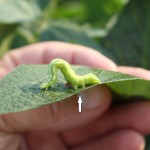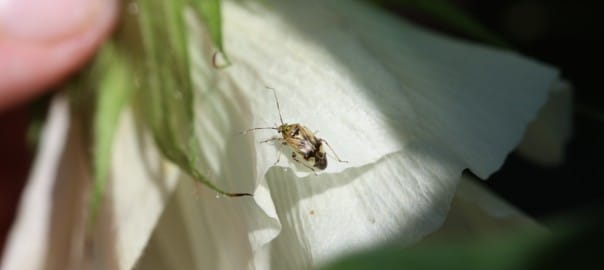Most the action is still centered around plant bugs with some stink bugs in the mix.
You will see higher moth catches in our corn earworm (bollworm) moth traps when the data get posted later this week. The last week of July and the first week of August is often the time we start seeing a few bollworm in the mix, particularly on WideStrike cotton. Let’s talk a little strategy for the next 2-3 weeks. Continue reading
All posts by Scott Stewart, West TN Research & Education Center
Final UT Soybean Scout School – July 14, Robertson County

The remaining Soybean Scout School is scheduled for 9:30 AM in Robertson County (see below). Scout Schools are 2-2.5 hour, field-side programs about the nuts and bolts of soybean growth and pest management. They are sponsored in part by the Tennessee Soybean Promotion Board and the USB. Scouting notebooks and sweep nets will be provided to participants while supplies last. Continue reading

Sugarcane aphids, whorl-feeding caterpillars, and bees in sorghum
Sugarcane aphids have now been confirmed in Shelby County. The good news is that populations are very low at this time, and it seems to me that we are on a similar schedule as last year. Thus, I’m hoping that much of the early grain sorghum will be at low risk to serious infestations. The bad news is we seem to be on a similar schedule to last year, and we should anticipate that Continue reading
Corn Borers in Corn
This is mostly a repeat of an article from last year and is intended as a reminder not to overlook corn borers, especially southwestern corn borer, in non-Bt corn. The second generation moth flight is starting. Overall moth catches have been low (click here for moth trapping data), but corn borer infestations can be Continue reading

Dealing with plant bugs during early bloom
Tarnished plant bug infestations in pre-flowering cotton have been pretty typical thus far … sporadic infestations with many but not all fields requiring at least one treatment. Realistically, I expect more consistent problems as we move through July. Below are a few thoughts about the best management practices for plant bugs over the next two weeks.
- Consider using a sweep net and a drop cloth in tandem during early bloom. As we progress further into bloom, I prefer the drop cloth because the population often shifts primarily to immatures. However, the 14 days just before and after bloom is a time where we might see mixed populations of nymphs and adults knock off squares and feeding on small bolls.
- Continue monitoring square retention in the top five nodes for 10-14 days after first bloom. Monitoring square retention after this point is generally not suggested for a couple of reasons. Later squares will not contribute much to yield. You can also get a ‘bad read’ as squares will naturally shed as the plant develops a fruit load.
- Treat for plant bugs when infestation levels average 15 or more plant bugs per 100 sweeps or when 3 or more plant bugs per drop cloth. It is very likley a second spray will be needed at a 4-5 day interval if infestations are several times threshold, particularly when the population is composed mostly of immatures.
- Use the right insecticide! We have several excellent treatment choices for cotton just prior to flowering and during the first two weeks of bloom. This is an good window for the use of 1.5 oz of Transform (1.5 oz/a) or Diamond (4-6 oz/a and usually tank mixed with Orthene/Acephate or Bidrin). Transform and Diamond provide unique modes of action. This is also a time where Acephate (0.67 – 0.75 lb/a) or Bidrin (5-8 oz/a) work well by themselves, although many will reserve the use of these products as tank mix partners with pyrethroids until later in the season when stink bugs and bollworms are a bigger part of the equation.
- Don’t use the wrong insecticides. Pyrethroid insecticides applied alone will provide little or no control of tarnished plant bug. Also, I suggest laying off neonicotinoid insecticides such as Centric or the imidacloprid products once past first bloom, in part for resistance management but also because they just don’t work as well in this window as immature plant bugs are a growing part of the population.
Note – Bidrin is not labeled for use during the interval of first square to first bloom. Please follow the label restrictions for this and other insecticides.
Stink Bugs in Soybean
I ran a similar article last year. Normally, stink bug infestations are worse in later planted soybean. They serve as a sink for bugs when other crops are maturing, and overall population levels have had all summer to build. However, we sometimes see high populations of adult stink bugs in soybean fields that are Continue reading
Moth Trapping Reminder
Just a reminder that weekly moth trap catches in pheromone traps can be accessed by clicking on “Moth Trapping Data” under Quick Links on the left menu of our news site. This includes catches of bollworm (corn earworm), tobacco budworm, and southwestern corn borer. There is nothing exciting to report at this time, but be on a lookout for a spike in southwestern corn borer catches over the next two weeks. Over the past several years, this has occurred sometime between late June and mid July.

Sorghum Midge – To Spray or Not to Spray
Economically damaging infestations of sorghum midge are not very common, particularly on early planted milo. However, high populations can cause substantial yield loss. This is a tiny orange fly, and because the larvae develop inside the seed husks. Thus, your only chance of controlling Continue reading
